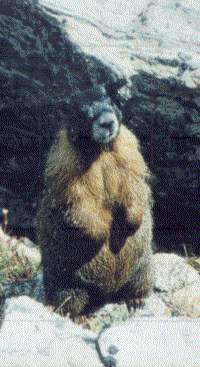Article by Lynda La Rocca
Wildlife – July 2002 – Colorado Central Magazine
What animal sleeps more than half the year, emits unusual noises, gobbles cookies by the bagful, and is often referred to as a “pig”?
If you’re thinking the answer is the family dog, think again. These are all characteristics of Marmota flaviventris, the yellow-bellied marmot.
Although it is most commonly seen sprawled on a boulder above timberline, basking in the summer sunshine, this housecat-sized, brownish-yellow furball is tougher, and much more alert and canny, than it seems.
[InContentAdTwo]
Marmots, the largest members of the ground squirrel family, live in mountainous regions at elevations ranging from 6,500 to 13,500 feet. They cope with this harsh habitat by sleeping — a lot. Marmots are true hibernators, turning in each year around September and reappearing again the following April or May, eager for a meal after having lost up to half their weight during their long winter’s nap.

When they’re not foraging, sunning, grooming, or sleeping, marmots spend their precious waking months constructing a hibernation den as deep as 15 feet beneath the hard ground. Almost exclusively vegetarian, marmots feast on flowering stalks whenever they find them, but primarily consume plants and grasses. These rodents also eat insects and are not averse to the occasional morsel of roadkill.
And high-country hikers know that marmots are skilled beggars, sitting back on their haunches to share any fruit, cookies, bread, or crackers tossed their way.
Hikers are also familiar with the series of high-pitched chirps, yips, trills, and whistles marmots emit on what seems like a nonstop basis. They even “chuck,” or cluck, which could explain the origin of the word “woodchuck.” The woodchuck, which is also known as a groundhog, think Punxsutawney Phil, is one of the 15 species of marmots which inhabit the Northern Hemisphere in both the Old and New Worlds.
Curiously though, woodchucks tend to remain silent. Perhaps that’s because there’s no one to talk to. Woodchucks are the most solitary of all marmot species.
Conversely, the West’s yellow-bellied marmots are social creatures, living in colonies of up to two dozen individuals. And theirs is a man’s world: male marmots maintain harems of breeding females who jointly raise the colony’s young, which are born in late May or June. Each female produces a single litter of three to eight annually, giving birth after a four-week gestation period. The young are weaned in another four weeks and stay with their mother throughout their first summer, sometimes even hibernating with her.
And while marmots may appear to be hanging out while lounging on their rock outcroppings, they’re really hard at work. These marmots are “lookouts,” guarding the colony’s burrows and protecting its offspring.
Dr. Daniel T. Blumstein, a University of California at Los Angeles professor and marmotologist (indeed, there is a name for people who study marmots), believes that marmot vocalizations — which have given rise to its nicknames of “rockchuck” and “whistle pig” — are more than just a way to warn the colony of danger.

Marmots, it seems, do not always vocalize at the approach of predators like mountain lions, coyotes, wolves, or golden eagles. The decision as to when, and whether, to vocalize reflects more than good parenting skills and the marmot equivalent of community cooperation. Blumstein theorizes that alarm calls are actually a way for individual marmots to ensure that their own genes dominate in future generations. In other words, marmots whistle when nuclear family members are threatened, but remain silent when a more distant relation is about to become cougar kibble.
While our own yellow-bellied marmots are not exploited by humans for economic purposes, woodchucks in the southern United States aren’t as lucky. There they are hunted and eaten, as they are in Mongolia, where native marmot species are particularly prized for their high-protein meat. In the Alps, a medicine made from marmot fat is used as a remedy for rheumatism. And in Russia marmots are sought after not only for their fur, but as an addition to the dinner table and for medicinal purposes.
Perhaps the oddest marmot-human connection occurred in Pakistan. Nearly 2,500 years ago, the Greek historian Herodotus wrote of large, furry, “golden ants” that enriched the Persian empire by burrowing for gold. These creatures turned out to be golden marmots (Marmota aurea) who were digging into a gold-bearing stratum of sandy soil several feet underground. Herodotus’ use of the word “ant” may have stemmed from confusion regarding the translation of what was actually the ancient Persian word for “marmot.”
For thousands of years, people looked askance at Herodotus’ account. Then in 1996, a group of visiting European explorers spoke with local tribespeople who explained that their ancestors had, for centuries, recovered bits of gold from sand that stuck to the marmots’ fur; the animals inadvertently brought the gold-bearing sand up and deposited it on the surface.
Now that’s a trick worth teaching the family dog.
Lynda la Rocca lives among the marmots near Twin Lakes.

